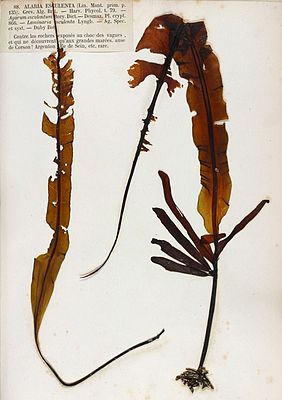Wing wrack
| Wing wrack | ||||||||||||
|---|---|---|---|---|---|---|---|---|---|---|---|---|

Winged wrack ( Alaria esculenta ) |
||||||||||||
| Systematics | ||||||||||||
|
||||||||||||
| Scientific name | ||||||||||||
| Alaria esculenta | ||||||||||||
| ( L. ) Greville |
The winged wrack ( Alaria esculenta ), also called edible belt wrack , is a type of brown algae from the order of the Laminariales . It is widespread on the coasts of the North Atlantic and North Pacific and is also found in the North Sea .
description
The winged seaweed is a perennial seaweed whose thallus reaches a length of 0.5 to 4 m. It is anchored to the ground with a strong, branched adhesive claw. A round, flexible stem 10 to 30 cm long merges into the strong central rib of the long, leaf-like phylloid . Only the stalk is persistent, the leaf surface is regenerated every year. The soft, brown to dark brown phylloid is narrow band-like with a width of 5 to 25 cm. The leaf margin is slightly wavy and often torn. The midrib stands out clearly, it is slightly flattened and yellow-brown in color.
At the top of the stalk arise laterally tightly two-line leaflets in which the spores are formed. These sporophylls with a length of 10 to 20 cm and a width of 1 to 2 cm are short-stalked, elongated with a wedge-shaped base and have no central rib.
From the species Undaria pinnatifida (Wakame) introduced in the north-east Atlantic , which also has a midrib, the winged wrack can be distinguished by its clearly protruding and usually lighter midrib and the sporophylls at the leaf base.
Occurrence
The distribution area of the wingtip includes the northeast Atlantic from Greenland and Spitzbergen to France , the northwest Atlantic from Newfoundland to New York and the North Pacific ( Alaska , Sea of Okhotsk , Korea ). It also occurs in the North Sea near Helgoland .
It colonizes rocks exposed to the waves and often forms large populations in the area of the low water line and in the shallow sublittoral . Occasionally it can also be found in tide pools .
Systematics
The winged wrack was first described in 1767 by Carl von Linné under the name Fucus esculentus (in: Systema Naturae 2, p. 718). Robert Kaye Greville placed the species in the genus Alaria in 1830 (in: Algae Britannica 34, p. 25).
Synonyms of Alaria esculenta (L.) Greville are Agarum esculentum (L.) Bory de Saint-Vincent, Ceramium esculentum (L.) Stackhouse, Fucus esculentus L., Laminaria esculenta (L.) C. Agardh , Musaefolia esculenta (L.) ) Stackhouse, Orgyia esculenta (L.) Stackhouse, Phasgonon esculentum (L.) SFGray and Podopteris esculentum (L.) De la Pylaie. Are considered more synonyms Agarum delisei Bory de Saint-Vincent, Alaria delisei (Bory) Greville, Alaria dolichorhachis Kjellman, Alaria grandifolia J.Agardh, Alaria linearis Strömfelt, Alaria macroptera (Ruprecht) Yendo, Alaria musaefolia (Bachelot de la Pylaie) J. Agardh, Alaria platyrhiza Kjellman, Fucus pinnatus Gunnerus, Fucus teres Goodenough & Woodward, Laminaria musaefolia Bachelot de la Pylaie, Orgyia delisii (Bory de Saint-Vincent) Trevisan, Orgyia pinnata Gobi and Phasganon macropterum Ruprecht.
Alaria esculenta belongs to the Alariaceae family in the order of the Laminariales .
use
The winged wrack is edible and is traded as "Irish Wakame".
swell
- Wolfram Braune: marine algae. A color guide to the common benthic green, brown and red algae of the world's oceans . Ruggell: Gantner, 2008, ISBN 978-3-906166-69-8 , pp. 178, 181 (sections description, occurrence)
- Michael D. Guiry, GM Guiry: Alaria esculenta - In: Algaebase - World-wide electronic publication, National University of Ireland, Galway , accessed April 24, 2012 (sections systematics, occurrence)
Individual evidence
- ↑ a b Michael Guiry: The Seaweed Site: information on marine algae: Alaria esculenta , accessed April 24, 2012.
